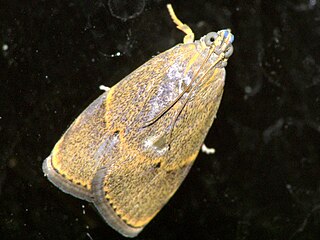
Imma is a large genus of moths in the obtectomeran "micromoth" family Immidae. This is the type genus of its family. They are widespread in the tropics, with most species occurring between the Himalayas and the Oceanian region; the genus is furthermore plentiful in the Neotropics, but not very diverse in the Afrotropics.

Imma mylias is a moth of the family Immidae. It is native to Sri Lanka, India, the Andaman Islands, the Philippines and Taiwan. It is an introduced species in Hawaii.

Gesonia obeditalis is a species of moth of the family Noctuidae first described by Francis Walker in 1859. It is found from eastern Africa, the Seychelles, the Maldives and the Oriental tropics of India, Myanmar, Sri Lanka east to the Philippines, the Sula Islands and Australia. The adult moth has brown wings with a scalloped dark brown band near the margin. The hindwings are similar in pattern to the forewings but are a paler shade of brown.

Imma albofascia is a moth of the family Immidae. It is known from Ambon Island (Indonesia), Sri Lanka and southern India.
Imma aulonias is a moth in the family Immidae. It was described by Edward Meyrick in 1906. It is found on the Solomon Islands.
Imma marileutis is a moth in the family Immidae. It was described by Edward Meyrick in 1906. It is found in Australia, where it has been recorded from Queensland and South Australia.
Imma metriodoxa is a moth in the family Immidae. It was described by Edward Meyrick in 1906. It is found on Sumbawa in Indonesia.
Imma nephallactis is a moth in the family Immidae. It was described by Edward Meyrick in 1906. It is found in Venezuela.
Imma psithyristis is a moth in the family Immidae. It was described by Edward Meyrick in 1906. It is found on the Solomon Islands.
Imma strepsizona is a moth in the family Immidae. It was described by Edward Meyrick in 1906. It is found on Sulawesi.
Imma psoricopa is a moth in the family Immidae. It was described by Edward Meyrick in 1906. It is found in Sri Lanka.
Imma thyriditis is a moth in the family Immidae. It was described by Edward Meyrick in 1906. It is found on the Solomon Islands.
Imma tyrocnista is a moth in the family Immidae. It was described by Edward Meyrick in 1906. It is found on India's Andaman Islands.
Imma monastica is a moth in the family Immidae. It was described by Edward Meyrick in 1910. It is found on Ambon Island in the Moluccas of Indonesia.
Imma vaticina is a moth in the family Immidae. It was described by Edward Meyrick in 1912. It is found in Australia, where it has been recorded from Queensland.
Imma grammarcha is a moth in the family Immidae. It was described by Edward Meyrick in 1905. It is found in Sri Lanka and possibly on Borneo.
Imma synconista is a moth in the family Immidae. It was described by Edward Meyrick in 1918. It is found in Kanara, India.
Imma accuralis is a moth in the family Immidae. It was described by Francis Walker in 1859. It is found in Sri Lanka.
Imma pardalina is a moth in the family Immidae. It was described by Francis Walker in 1863. It is found on Borneo and in Malaysia (Selangor) and Singapore.
Imma congrualis is a moth in the family Immidae. It was described by Thomas de Grey in 1900. It is found in New Guinea.

